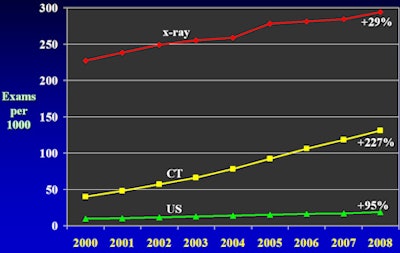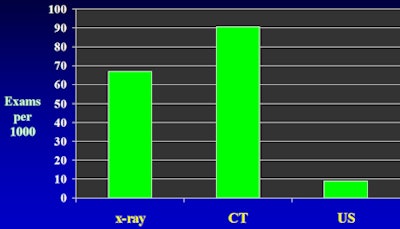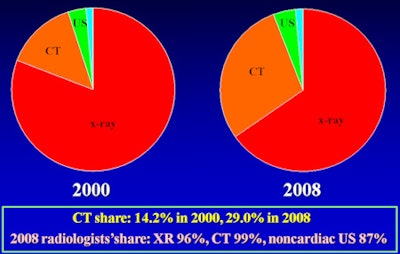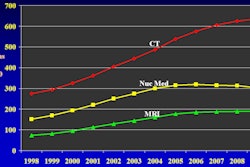
In research that confirms previous studies, a group from Thomas Jefferson University in Philadelphia says that the rate of imaging use in U.S. emergency departments (EDs) has exploded, particularly in CT, with the modality's share of ED imaging doubling between 2000 and 2008 -- due in part to physicians practicing defensive medicine.
"The rate of utilization of imaging is increasing in emergency departments," lead author and study presenter Vijay Rao, MD, told AuntMinnie.com. "And the growth is by far the most pronounced in CT, both in terms of the growth rate itself and the actual number of accrued new studies per 1,000 beneficiaries. The reasons for this are multiple, from the cultural shift in how we practice medicine to a more defensive model, to an increasing dependence on new technology."
Rao and colleagues examined utilization trends in the three primary emergency department imaging modalities: plain x-ray, CT, and ultrasound. The team used data from the nationwide Medicare Part B Physician/Supplier Procedure Summary Master Files for 2000 through 2008, examining all diagnostic CPT codes for these three modalities (as well as echocardiography). The group also used physician specialty codes to identify provider specialties and track the percentage of emergency department studies interpreted by radiologists.
The group found that the overall utilization rate per 1,000 patients for all imaging types in emergency departments increased 60% between 2000 and 2008, from 281 procedures per 1,000 beneficiaries to 450 procedures, respectively. CT's growth was most dramatic: In 2000, CT made up 14% of all emergency department imaging; by 2008, it took up 29% of the total ED imaging share.
 |
| Modality use trends: 2000 to 2008. All images courtesy of Vijay Rao, MD. |
Results for specific modalities (all rates per 1,000 patients) are as follows:
- The x-ray utilization rate rose from 227 procedures in 2000 to 294 procedures in 2008 (an increase of 29%, with 67 accrued new studies per 1,000).
- CT's utilization rate rose from 40 procedures in 2000 to 131 procedures in 2008 (a 227% increase, with 91 accrued new studies per 1,000).
- Ultrasound's use rate rose from 10 procedures in 2000 to 19 procedures in 2008 (an increase of 95%, with nine accrued new studies per 1,000).
 |
| Accrued new studies per 1,000 patients: 2000 to 2008. |
Radiologists strongly predominate as the physicians of record for all ED imaging, and especially in x-ray and CT, according to Rao. In 2008, radiologists billed for 96% of all ED imaging exams (x-ray at 96%, CT at 99%, and noncardiac ultrasound at 87%).
 |
| Share by modality. |
The study by Rao and colleagues supports two other studies in recent months that confirm a surge in CT use that's driving imaging growth in the ED. In a study also presented at the 2010 RSNA meeting, researchers from Cincinnati Children's Hospital found that CT use increased at an average of 16% per year from 1995 to 2007.
And a study published in the October 6, 2010, edition of the Journal of the American Medical Association found that patients who presented to the emergency department for an injury-related condition in 2007 were three times more likely to get a CT or MRI scan than patients presenting with similar conditions in 1998.
Why is there this explosive growth of imaging, particularly CT, in the emergency department? Defensive medicine is a huge issue, Rao told AuntMinnie.com.
"The major conditions that spark CT use in the emergency department now are chest pain, or the possibility of pulmonary embolism, and abdominal pain," she said. "And of course, everyone gets a CT for trauma."
But regardless of who is ordering the exams, the spike in imaging use in emergency departments should be tracked, Rao said.
"Dramatic increase in CT utilization should raise concern about inappropriate utilization and associated radiation risk," she said.
There are a few things that can be done to address the increased use, according to Rao, including instituting standardized guidelines for imaging that outline clinical indications for particular episodes of care, and internal monitoring of a facility's emergency department doctors' test ordering practices.
"We need standardized, evidence-based guidelines -- adopted nationally as best practice -- that will stand up to scrutiny in a court of law," Rao said. "They could be incorporated at the radiology order-entry level. And in the interim, it would be useful for emergency departments themselves to monitor their physicians' ordering practices to look for patterns."
By Kate Madden Yee
AuntMinnie.com staff writer
January 3, 2011
Related Reading
Study finds surge in emergency department use of CT, November 30, 2010
Education for ER staff could reduce repeat CT scans of kids, October 18, 2010
CT drives big jump in imaging use in emergency rooms, October 5, 2010
Report: Use of advanced imaging up in ED, September 10, 2010
Cardiac MRI can help cut costs in the ER, June 29, 2010
Copyright © 2011 AuntMinnie.com





















